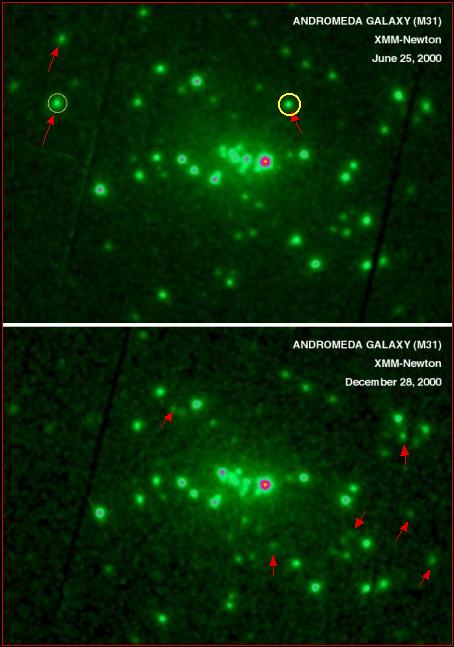
 Credit: S. Trudolyubov and ESA
Credit: S. Trudolyubov and ESA
X-ray Flashers in M31
The Milky Way's neighbor, the Andromeda Galaxy (M31) is a large spiral
galaxy similar to the Milky Way. X-ray astronomers like to study M31 since
they can see the entire galaxy at once. This lets them determine the
population of black holes and other compact objects and to see how these
objects are distributed through the galaxy. Since all the objects in M31
are at nearly the same distance from us, this enables astronomers to get
an accurate measure of the object's luminosity. X-ray astronomers also
have an advantage over optical astronomers, since the number of compact
objects in M31 (or in any galaxy for that matter) is much less than the
number of visible stars, so source confusion is not much of an issue. Also,
since most compact X-ray sources vary, detection of variability is a big
help in distinguishing X-ray bright compact objects from X-ray bright
extended objects (like young supernova remnants). The most sensitive X-ray
pictures of M31 have recently been obtained by the EPIC camera on
the XMM-Newton
observatory. The XMM-Newton images of the center of M31, shown above, were
obtained roughly 6 months apart and show dozens of X-ray sources (including
a supermassive
black hole near the very center of M31). The source within the green
circle is an usual X-ray transient in which the energy of the emitted
X-rays is very low, and the source within the yellow circle is newly
discovered X-ray Nova designated XMMU J004234.1+411808. Many of these
sources are variable; some of the more obvious variables are indicated by
the red arrows. You can see an impressive display of source variability by
blinking
the images.
Last Week *
HEA Dictionary * Archive
* Search HEAPOW
* Education
Each week the HEASARC
brings you new, exciting and beautiful images from X-ray and Gamma ray
astronomy. Check back each week and be sure to check out the HEAPOW archive!
Page Author: Dr. Michael F.
Corcoran
Last modified July 3, 2001


